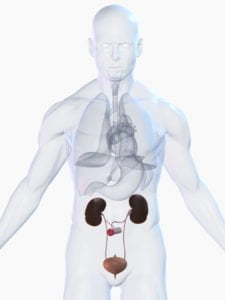 When a person’s bladder Is no longer working or has been surgically removed, a urostomy procedure is done. There are many reasons why a person’s bladder isn’t functioning properly or was removed. Some of these causes include bladder cancer, neurological dysfunction, birth defect like bladder exstrophy or spina bifida, spinal cord injury, or chronic inflammation of the bladder.
When a person’s bladder Is no longer working or has been surgically removed, a urostomy procedure is done. There are many reasons why a person’s bladder isn’t functioning properly or was removed. Some of these causes include bladder cancer, neurological dysfunction, birth defect like bladder exstrophy or spina bifida, spinal cord injury, or chronic inflammation of the bladder.
There are two main types of urostomy procedures, the standard or conventional urostomy and the continent urinary reservoir.
With a standard or conventional urostomy, an “ileal conduit” is made. To make the ileal conduit, the surgeon takes a small piece of the patient’s small intestine and sews it together into a pouch or basically a “new” bladder. With a normal functioning bladder, there are two tubes that go from the kidneys to the bladder. These tubes are called ureters, and they are what transports the urine from the kidneys to the bladder. The surgeon will disconnect the ureters from the bladder and connect them to the ileal conduit. Depending on the situation, the bladder may be removed or left in place. The ileal conduit is then placed near the abdominal wall and a stoma is created. A stoma is basically a hole in the abdominal wall were the ileal conduit is connected to the abdominal wall and where urine can escape the body through the stoma. A collection pouch or bag is connected to the stoma to collect the urine. There is no control as to when the urine is released into the pouch.
Continent urostomies are like standard or conventional urostomies in that an internal pouch or “new bladder” is created. Yet, a valve or a couple of valves are created to keep the urine inside the pouch until it is drained a few times a day with a catheter. A catheter is basically a flexible hose that is pushed through the valve into the new bladder allowing the collected urine to flow outside the body. There are a several types of continent urostomy procedures. Some of these procedures even use the patient’s own urethra to drain the urine instead of a stoma. It all depends on the individual patient’s situation and preference. In any case, a Urostomy is a life changing procedure.
For Urostomies that have a stoma, there are two types of pouches. One-piece and two-piece systems. The one-piece system has a skin barrier that is attached to the pouch. They usually have a drain on the bottom that is opened to release the collected urine. Any type of urostomy should be changed regularly because bacteria can grow inside the external collection pouch. With the one-piece system, the whole pouch and skin barrier are removed and discarded.
The two-piece system has a skin-barrier and a pouch. The skin-barrier is attached to the skin around the stoma and the pouch is connected to the barrier. When it is time to change the pouch, it is disconnected from the skin barrier and a new pouch is connected to the same skin barrier. The skin barrier does have to be changed occasionally, but it is easier to regularly change the pouches with this system.
In any case, the skin barrier must be fitted properly so it does not cause irritation to the surrounding skin or the stoma. It should also be fitted so it does not leak. If it is leaking, a new skin barrier should be placed.
At night time, or for patients that are paralyzed, a drainage system can be used that connects the external urostomy pouch to a drain bag that can be hung from the bed. It must always be placed below the urostomy pouch and the tube from the urostomy pouch to the drain bag should not be twisted or kinked.
Home health agencies have nurses that are trained in urostomy care. In many cases, if insurance covers it, patients that are having difficulty managing their urostomy can have a home health care nurse provide urostomy cares. If you or someone you care for needs help with a urostomy, we are here to help.
Recent Comments